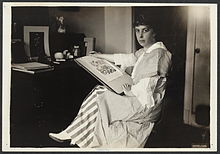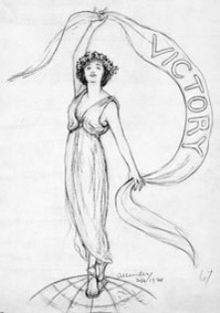Nina E. Allender
Nina Evans Allender (December 25, 1873 – April 2, 1957) was an American artist, cartoonist, and women's rights activist.
[2][3][a] Her father, David Evans was from Oneida County, New York and moved to Kansas, where he served as a teacher before becoming superintendent of schools.
[7][8] The Evanses lived in Washington, D.C. by September 1881 when Eva Evans was working at the Department of the Interior as a clerk in the Land Office.
[3] David Evans worked at the United States Department of the Navy as a clerk[10] and was a poet[11][12][13] and short story writer.
[26] During one European study trip she became good friends with modernist painters Charles Sheeler and Morton Schamberg.
[28] At the age of 38, Nina Allender became actively involved in the National American Woman Suffrage Association (NAWSA).
"[30] Within the year she became president of the District of Columbia Woman Suffrage Association and was a featured speaker at numerous local gatherings.
Allender shared the speaker's platform with future congresswoman Jeannette Rankin,[32] one of about 14 women representing multiple states to meet with President Woodrow Wilson in a suffrage deputation.
[35] Inez Haynes Irwin stated that both Eva and Nina had readily agreed to make monthly financial donations and volunteer their time for the organization.
[46] The National Woman's Party sent valentines, designed by Allender, on February 14, 1917, to President Wilson and legislators as a softer appeal in the campaign to attain women's right to vote.
A 1918 review of her work conceded that her early period "dealt with old suffrage texts, still trying to prove that woman's place was no longer in the home.
[53] Her depiction of the "Allender girl," captured the image of a young, capable American woman,[54] embodying "the new spirit that came into the suffrage movement when Alice Paul and Lucy Burns came to the National Capital in 1913.
"[51] She gave to the American public in cartoons that have been widely copied and commented on, a new type of suffragist—the young and zealous women of a new generation determined to wait no longer for a just right.
It was named Amelia Himes Walker's "Jailed for Freedom" pin in acknowledge the two-month period when the woman's rights activist was imprisoned in the Occoquan Workhouse and the incarceration and abuse that had been suffered by other suffragettes.







